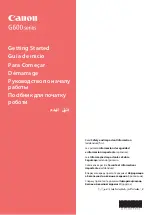
44951501TH Rev.2
1-8 /
Oki Data CONFIDENTIAL
1. CONFIGURATION
C301dn
C321dn
Automatic
feeding by a
second tray
unit (option)
Tray
capacity
Tray1:
250 sheets of 82g/m
2
(70kg) plain paper, 25mm or
less in total thickness
Multi-purpose tray:
100 sheets of 82g/m
2
(70kg) plain paper, 10mm or
less in total thickness, 10 envelopes of 85g/m
2
paper
Paper
ejection *2
Face-up (ejecting paper with the front side up)/
Face-down (ejecting paper with the back-side up)
Stacker
capacity *3
Face-up:
100 sheets of 82g/m
2
(70kg) plain paper
Face-down:
150 sheets of 82g/m
2
(70kg) plain paper
Assured
print area
Area excluding 6.35mm from paper edges (except
special media such as envelopes)
accuracy
Print start position accuracy: ±2mm,
Paper skew: ±1mm/100mm
Image expansion: ±1mm/100mm (in use of 82g/m
2
of 70kg paper)
Warm-up
time
In 60 sec. after power on (25°C) *4
Within 32 sec. from power saving
Power
AC 220 - 240 V, 50/60Hz ± 2%
Power
consumption
Operating:
Max. 1170W,
Average 480W (25°C)
Ready:
Average 80W (25°C)
Power save mode:
Less than 9.5W
Sleep mode:
Less than 2.5W
Off Mode:
Less than 0.5W
Operating:
Max. 1170W,
Average 480W (25°C)
Ready:
Average 90W (25°C)
Power save mode:
Less than 14W
Sleep mode:
Less than 1.5W
Off Mode:
Less than 0.5W
Inrush
current
70A or less (25°C)
C301dn
C321dn
Operating
environment
conditions
Operating: 10 to 32°C, 20 to 80% RH (max. wet-
bulb temperature:
25°C, max. wet- and dry-bulb temperature
difference: 2°C)
Non-operating: 0 to 43°C, 10 to 90% RH (max.
wet-bulb temperature:
26.8°C, max. wet -and dry-bulb temperature
difference: 2°C)
Print quality
assured
conditions
30 to 73% RH at 10°C, 30 to 54% RH at 32°C, 10
to 32°C at 30% RH, 10 to 27°C at 80% RH, 17 to
27°C at 50 to 70% RH in color printing
Standard
operating
conditions
Average power–on hours: 600 hours/month
Average number of printed pages: 6,000 pages/
month
Consumables,
maintenance
units
Toner cartridges, Image Drum units, Belt units,
Fuser units
Printer life
5 years or 300,000 pages (A4)
Total weight
*5
Approx. 22kg
*1: Print speed varies depending on sizes, types and thickness of paper and paper feed types.
*2: There are limitations on paper feed types and paper ejection types depending on paper
sizes, types and thickness.
*3: The stacker capacities may different from the specifications depending on operating
environment.
*4: The warm-up time may vary depending on network environment etc.
*5: The total weight includes weight of the main unit and consumables. It doesn’t include
weight of options and paper.














































